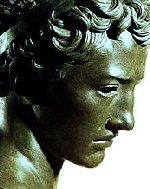Post by Ewig Berter on Jan 22, 2006 17:00:21 GMT -5
seizure said:
What are its distinctive features?The berberid core formed out from the superposition of two mediterranean types :
1. Ibero-Maurusians
These people were Mechtoids, an indigeneous northwest african form of Cromagnon man. They are associated with Iberomaurusian and Oranian Cultures, found along the northern coasts of NWA (--- Riff and Kabylie Regions).
Ibero-maurusian Culture :
A stone tool culture characterized by small backed bladelets and found across the North African coast from at least 22,000-10,000 years ago (the late Würm (last) glacial period). It followed the Aterian in the Epipalaeolithic of Maghreb in North Africa and preceded the Capsian. The culture was related to Cro-Magnon, A Group of people known as the Mechta-el-Arbi race, living along the Mediterranean from Tunisia to Morocco and also Libya. Linked to the sea, there are huge shell mounds of mussels, oysters, and arca. Associated with these are pottery and limited stone tool industry, in conjunction with hearths, sometimes still marked by supporting stones. Extensive cemeteries have been investigated, as at Taforalt, and also at Afalou bou Rhummel and Columnata in Algeria. Burials were sometimes decorated with ochre or accompanied by food remains or by horns of wild cattle. The industry does bear a close resemblance to the late Magdalenian culture in Spain, which is broadly contemporary (c 15,000 BC). There is evidence suggesting that the Ibero-Maurusian industry is derived from a Nile River valley culture known as Halfan, which dates from c 17,000 BC.
Oranian Culture :
North African culture of late Upper Palaeolithic type, with many backed blades and some microliths. A few inland sites are known, but most are concentrated along the Mediterranean littoral from Cyrenaica (the Haua Fteah) to Morocco. The time range is c 12,000-8000 BC. It is contemporary with the Capsian, though the Capsian sites are all inland, whereas the Oranian has a coastal distribution. Both are microlithic tool complexes that persisted after the introduction of Neolithic traits into the area.
2. Capsians
People associated with archeological cultures related to Gafsa/Capsa Culture, which developped mainly on in-land sites of NWA :
Capsa Site :

Capsa Culture :
a Mesolithic (8000 BC–2700 BC) cultural complex prominent in the inland areas of North Africa. Its most characteristic sites are in the area of the great salt lakes of what is now southern Tunisia, the type site being Jabal al-Maqta', near Qafsah (Capsa, French Gafsa). Although the tool kit of the Capsian is a classic example of the industries of the late Würm Glacial Period, and, while it is apparently related to the Gravettian stage of Europe's Perigordian industry (which dates from about 17,000 years ago), it does not properly belong to the glacial period at all but clearly occurs in Neothermal (postglacial) times. Like its predecessor, the Ibero-Maurusian industry (or Oranian industry), the Capsian was a microlithic (tiny-flaked-blade) tool complex. It differed from the Ibero-Maurusian, however, in displaying a far more varied tool kit distinguished by large backed blades and burins in its earlier phase and a gradual development of geometric microliths later. These became its leading feature by the 6th millennium BC, when they seem to have been transmitted to the final Ibero-Maurusian groups along the coast.
Some North African rock paintings are attributed to people of the Capsian industry.
Rock paintings of Garamantes

From my personal experience, I can roughly describe the capsian berbers as a relatively-tall, gracile, long-faced people, they are very comparable in those aspects with pure Arabians; Dominant skin color: brwon.

